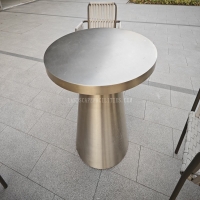Welcome to the website for landscape facilities products and knowledge.
How do landscape tables in residential settings balance privacy and social interaction?
Landscape tables in residential settings serve as versatile hubs for both private relaxation and social engagement. Their design plays a pivotal role in harmonizing these seemingly opposing needs.
1. Strategic Placement
Positioning tables near natural barriers (hedges, trellises, or water features) creates semi-private zones while maintaining visual connectivity. Corner placements with angled seating foster intimate conversations without full isolation.
2. Multi-Level Design Solutions
Tiered tabletops or sunken seating areas create psychological boundaries, allowing smaller groups to interact comfortably within larger gatherings. Pergola-shaded tables with adjustable side screens offer adaptable privacy control.
3. Material Intelligence
Translucent materials (perforated metals, frosted glass) filter sightlines, while strategic planters with trailing vines provide organic visual buffers. Acoustic-absorbing materials like textured wood reduce noise spillover.
4. Dynamic Configurations
Modular tables with movable benches or rotating sections enable quick transitions between social and private modes. Circular designs with central planters naturally regulate interaction distances.
5. Sensory Boundaries
Incorporating elements like bubbling water features or rustling bamboo screens creates auditory privacy without physical barriers, maintaining an open atmosphere.
Smart landscape table design transforms residential outdoor spaces into fluid environments where solitude and socialization coexist through thoughtful spatial choreography rather than rigid separation.
Related search:

Recommendation
Outdoor Metal Table - Classic Outdoor Furniture, Stainless Steel Table, Durable and Reliable